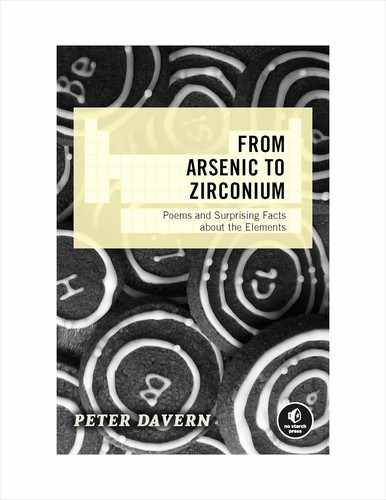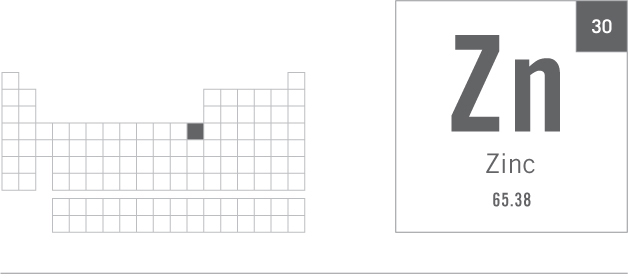ZINC, Zn
TASTE AND SMELL
In countless enzymes, proteins too, hard brittle zinc’s a must,
GROUP 12 TRANSITION METAL
Zinc is a fairly hard, yet brittle, bluish-white metal that sits at the far end of the first row of transition metals. It’s an essential trace element for humans and animals and plays an important role in the function of hundreds of enzymes and proteins within the body.
see-oh-two
Helps regulate your CO2, white blood cells kept robust.
The enzyme carbonic anhydrase uses a zinc ion (Zn2+) at its “heart” to efficiently regulate the level of carbon dioxide (CO2) in your body by reversibly converting it to hydrogencarbonate (HCO3–, bicarbonate) as needed, thus controlling the acidity of your blood and tissues. It also plays an important role in respiration by facilitating the transport of carbon dioxide away from cells to the lungs.
Zinc is essential for ensuring that your immune system maintains its capacity to defend your body against infectious diseases. Zinc deficiency adversely affects the normal functioning of the various types of white blood cells that make up your immune system.
Helps brains to process taste and smell,
Zinc activates the areas of the brain that receive and process information from taste and smell sensors.
Treats dandruff, rash, and scalds as well.
The organozinc compound zinc pyrithione has antifungal properties and is the active ingredient in many popular antidandruff shampoos. Zinc also helps in the renewal of skin cells. Calamine lotion and zinc ointments (which all contain zinc oxide, ZnO) have long been used to treat scalds, sunburn, and skin conditions, such as eczema and diaper rash.
Oft sacrific’d for pipe and ship: helps galvanize ’gainst rust.
Metallic zinc blocks are often either physically bolted or electrically connected (by wires) to steel structures, such as bridges, railway tracks, underground pipes, and ship hulls. The blocks act as sacrificial anodes by protecting the iron in the steel from oxidizing (or rusting: see “Iron, Fe” on page 74); the blocks corrode away instead.
Alternatively, steel objects might be coated with a layer of zinc, either by electroplating or by simply dipping them in molten zinc. This layer then protects the underlying steel from exposure to the water and oxygen present in moist air, preventing rust. Should the steel become exposed by a scratch in its galvanizing zinc layer, the zinc oxidizes, selflessly sacrificing itself to protect the iron.

